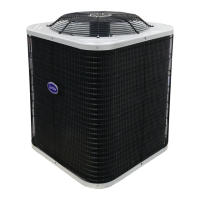C. Introduction
An application is considered Long Line, when the refrigerant level in the system requires the use of accessories to maintain acceptable
refrigerant management for systems reliability. See Table 1 for required accessories. Defining a system as long line depends on the
liquid line diameter, actual length of the tubing, and vertical separation between the indoor and outdoor units.
For Air Conditioner systems, the chart below shows when an application is considered Long Line.
AC WITH PURON® REFRIGERANT LONG LINE DESCRIPTION ft (m)
Beyond these lengths, long line accessories are required
Liquid Line
Size
Units On Same Level Outdoor Below
Indoor
Outdoor Above
I
n
door
1/4
No accessories needed within
allowed
length
s
No accessories needed within
allowed
length
s
175 (53.3)
5/16
120 (36.6) 50 (15.2) vertical or 120 (36.6)
to
tal 120 (36.6)
3/8
80 (24.4) 35 (10.7) vertical or 80 (24.4)
to
tal 80 (24.4)
For Heat Pump systems, the chart below shows when an application is considered Long Line.
HP WITH PURON® REFRIGERANT LONG LINE DESCRIPTION ft (m)
Beyond these lengths, long line accessories are required
Liquid Line
Size
Units On Same Level Outdoor Below
Indoor
Outdoor Above
I
n
door
3/8
80 (24.4) 20 (6.1) vertical or 80 (24.4)
to
tal 80 (24.4)
Long line applications are clearly defined in this Guideline, and must be treated differently from standard systems. A long line system
requires special consideration for the following reasons:
• Additional refrigerant charge
• Refrigerant migration control
• Oil return concerns
• Capacity losses
• Metering device adjustments
Longer line sets require additional refrigerant charge that must be managed throughout the entire range of possible ambient conditions.
Off- cycle refrigerant migration that results in excess refrigerant in the compressor at start up, or condensed liquid refrigerant in the
suction line at startup must be avoided for compressor reliability. Follow all accessory requirements in this Guideline to control off-
cycle refrigerant migration (see Table 1).
Another concern is proper line set sizing and construction to control oil return to the compressor, and minimize capacity losses. In
residential applications, proper suction line sizing is critical to achieve adequate oil return, and maintain expected system performance. Oil
return in heating mode is different from cooling mode thus, in some cases; heat pumps have additional line set limitations from air
conditioning units. Table 3 in this guideline can be used to properly size suction lines. Follow all suction line sizing recommendations to
ensure system performance and adequate oil return for compressor lubrication.
The third
concern is refrigerant metering. Elevation changes affect pressure drop in refrigerant lines. These effects must be considered
when sizing liquid lines and orifice- metering devices. Since all current products utilize a TXV for cooling mode metering, piston
sizing is only a concern for heat pump heating operation. Follow piston change recommendations in this Guideline for proper heat
pump heating operation (see Tables 9 & 12).
Since the last revision of this guideline, testing has been done to determine limitations for the application of 1/4 and 5/16 inch liquid
lines in cooling only systems. The limiting factor when sizing liquid lines is pressure drop. Equivalent length and vertical separation
both contribute to the pressure drop in a liquid line. The liquid line sizing charts in this guideline have been developed based on a TXV
metering device on the indoor coil. Staying within these guidelines and charging to a minimum of 10°F (5.6°C) subcooling will ensure a
column of liquid is present at the TXV. There is no capacity of efficiency changes to the system performance when staying within these
guidelines.
NOTE:
When an application is “Long Line” the accessories shown in Table 1 are required. D.
General Limitations
Liquid Lines - AC Only
Liquid line diameters of 1/4” and 5/16” and 3/8” are allowed for cooling only systems and limitations are provided. Using smaller
liquid lines affects the maximum allowable equivalent length and when the application qualifies as long line. Elevation changes
between the indoor and outdoor units also affect allowable equivalent lengths. See tables 5, 7, and 10 to properly size liquid lines.
NOTE: Using 1/4 and 5/16” liquid lines within the limits provided, result in no capacity or efficiency changes to the system.
Liquid Lines - Heat Pump
Liquid line sizing for heat pumps is currently limited to 3/8”. Future updates are planned to include alternate liquid line sizing for heat
pump applications. Check HVAC Partners for updates.
Suction Lines
Use
Table 3 to properly size suction lines. Acceptable suction line sizes are shown for each size and type system. Air conditioners and
heat pumps have separate charts due to oil return needs for heat pumps in heating mode.

